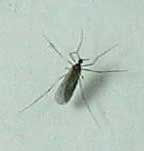 The
Hessian fly changes wheat growth by injecting poisons into the
plants, but a newly discovered resistance gene that can kill the
insect may add a new defensive weapon for the grain crop.
The
Hessian fly changes wheat growth by injecting poisons into the
plants, but a newly discovered resistance gene that can kill the
insect may add a new defensive weapon for the grain crop.
Using the new gene in combination with other genes is expected
to extend resistance time to the most economically damaging
insect of wheat by as much as six times. Scientists from
Purdue University and the
U.S. Department of
Agriculture-Agricultural Research Service (USDA-ARS) mapped
the new gene and two closely linked markers, or bits of DNA,
that indicate its presence in soft red winter wheat.
|
Results of the study are published in
this month's issue of the journal
Theoretical and Applied Genetics.
"Although 30 other genes resistant to the
Hessian fly are known, this is the first resistance gene
found on this particular chromosome," said Christie
Williams, Purdue entomology assistant professor and USDA-ARS
scientist. "The unique chromosomal location is important
because it will allow us to easily pyramid the gene with
other resistance genes to extend the durability of
resistance against this pest."
When several genes are combined in one
plant to create the desired effect, in this case better
resistance to the Hessian fly, it is called pyramiding. In
order to pyramid genes successfully, they must be in
different locations in the genome. |
 |
|
Purdue
researcher Christie Williams says the discovery of a gene in
wheat plants like the ones she holds in her lab may help the
plant resist damage from the tiny Hessian flies hovering
above the plants. (Agricultural Communications photo/Tom
Campbell) |
Now that Purdue researchers have discovered the gene, called
H31, and know that it's on a different chromosome than
previously known Hessian fly resistance genes, they will
intentionally breed wheat plants with three different Hessian
fly resistance genes, Williams said. This should be especially
effective because all of the genes to be used are strong genes -
in other words, 100 percent of the plants containing them would
be resistant under almost any stress, such as drought.
Conventional agricultural crossbreeding and selection is used to
transfer the Hessian fly resistance genes into a single plant.
It doesn't involve any genetic engineering.
The soft red winter wheat studied in this research is used
mainly for pastries, although the H31 resistance gene has
its origin in pasta wheat. The researchers used an insect that
is a widespread and highly virulent strain, the L biotype of the
Hessian fly.
 |
Hessian fly infestations have been
controlled for about 60 years in the United States by wheat
varieties naturally resistant to the fly. Hessian flies can
overcome a single newly released resistance gene in about
eight years, Williams said.
However, by combining several different
genes that afford protection from the pest, scientists
believe resistance can be extended for 50 years.
"Computer modeling predicts that if three
Hessian fly resistance genes are combined in one cultivar -
or line of wheat - and planted along with a few susceptible
plants that serve as a refuge for weaker strains of the fly,
we can extend the durability of resistance," she said.
|
|
This photo, with common keys as
a comparison, shows the actual size of Hessian flies.
(Agricultural Communications photo/Tom Campbell) |
"We want to pyramid the resistance genes in wheat plants because
it's much harder for the Hessian fly to overcome three different
resistance genes simultaneously." For the flies and the plants,
it's the old axiom: survival of the fittest.
The flies conquer the plants' resistance because a few of the
insects are genetically strong enough to survive on resistant
plants that kill the majority of the larvae. When two surviving
Hessian flies mate,
their offspring are capable of overcoming the plant's
resistance. This continues until all the flies in the area are
able to withstand the plants' genetic protection.
At
that point, a new line of plants with different resistance genes
must be found.
The method of using natural genes in the plants to protect
against a pest is called host plant resistance.
"Host plant resistance is really the preferred way of dealing
with many insect problems because it lessens the need to apply
chemicals that can degrade the environment," Williams said.
The Hessian fly, which German mercenaries apparently introduced
to North America during the Revolutionary War, causes
catastrophic losses if not controlled by resistant plants. In
Morocco, which didn't have resistant plants until recently, the
Hessian fly destroyed 36 percent of the country's wheat crop
annually. During the 1980s the state of Georgia suffered $28
million in lost wheat in one year after the fly overcame the
plants' resistance gene used in the area at the time.
The Hessian fly is particularly insidious because it actually
can control the wheat plant's development.
The adult fly lays eggs on the plant leaves. After the eggs
hatch, the resulting tiny, red larvae crawl down to the base of
the wheat where they feed on the plant. If the plant isn't
resistant to the insect, the
larvae inject chemicals from their saliva into the plant that
completely alter the wheat's physiology and growth. The plant
stops growing and actually begins producing more sugar and
protein in order to feed the larvae. Specialized cells develop
in the wheat plant so that the insect has the perfect
environment to grow, Williams said.
"If the plant is resistant, there is no visible sign that the
flies have been on the plant," she said. "Resistant plants will
kill the larvae in about four days."
Williams and her research team hope to determine the biochemical
processes that allow the Hessian fly to control the plants and
also the ones that enable the plants to kill the insect.
Other scientists involved with this study are: Chad Collier,
Department of Entomology and USDA-ARS laboratory technician;
Nagesh Sardesai, Department of Entomology postdoctoral fellow;
Herb Ohm, Department of Agronomy professor; Sue Cambron,
USDA-ARS research associate. USDA provided funding for this
study.
ABSTRACT
Phenotypic assessment and mapped markers for H31, a new wheat
gene conferring resistance to Hessian fly (Diptera:
Cecidomyiidae) C.E. Williams1, C.C. Collier1, N. Sardesai2, H.W.
Ohm3, and S.E. Cambron1
A
new source of resistance to the highly virulent and widespread
biotype L of the Hessian fly, Mayetiola destructor (Say), was
identified in an accession of tetraploid durum wheat, Triticum
turgidum
Desf., and was introgressed into hexaploid common wheat,
Triticum aestivum L. Genetic analysis and deletion mapping
revealed that the common wheat line contained a single locus for
resistance, H31,
residing at the terminus of chromosome 5BS. H31 is the first
Hessian fly-resistance gene to be placed on 5BS, making it
unique from all previously reported sources of resistance. AFLP
analysis identified two markers linked to the resistance locus.
These markers were converted to highly specific sequence-tagged
site markers. The markers are being applied to the development
of cultivars carrying multiple genes for resistance to Hessian
fly biotype L in order to test gene pyramiding as a strategy for
extending the durability of deployed resistance.